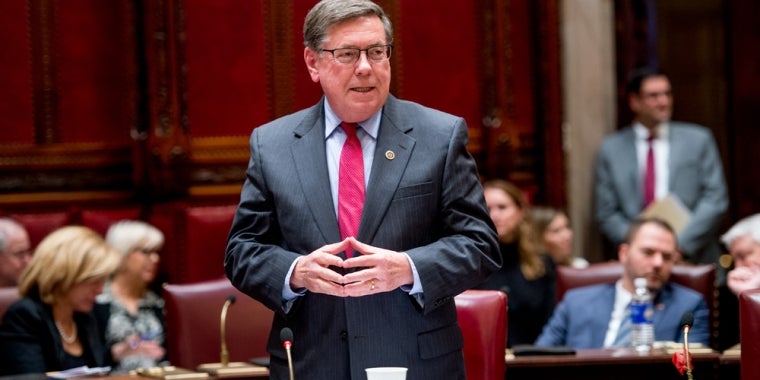
Seward Hails Workers' Comp Accord
Senator James L. Seward today hailed an agreement by the governor and legislature to enact significant new reforms of the state’s workers’
compensation system.
When enacted into law, benefits for injured workers will be increased for the
first time in more than a decade, and employers' costs, which are among the
highest in the nation, will be reduced by 10 to 15 percent with savings to
grow over time.
"Real workers' compensation reform was one of my goals this year, and after years of struggle, we have won results for the people of the state," Seward said. "Today's announcement caps years of effort by the senate majority to win reforms that benefit both employers and injured workers."
"Under this agreement, the weekly benefit for injured workers would be
raised significantly and, for the first time in the state’s history, an
on-going maximum benefit rate increase would be indexed and not ever
require further action by the Legislature or Governor, a provision the
Assembly has long fought for," said Speaker Sheldon Silver. "With this
plan, we strike a balance by establishing a more effective and just
compensation system for injured workers while also providing insurance
premium savings to employers. By protecting workers and reducing the costs
to businesses, this historic agreement establishes a more effective
environment for economic development and will spur job creation in the
hard-pressed western New York economy and throughout New York State."
"The agreement on workers compensation reform is a tremendous victory for
workers, who will receive increased benefits, and for businesses that will
see a significant reduction in premiums," said Senate Majority Leader Joe
Bruno. "Many of the reforms in this plan result from bills passed by the
Senate over the past decade, as well as initiatives discussed at workers
compensation roundtables held by Senator George Maziarz. I congratulate
Senator Maziarz and the representatives of business and labor for working
together to deliver a result that will strengthen businesses and protect
employees."
Key elements of the comprehensive reform package are as follows:
The maximum weekly benefit for injured workers will be increased from
$400 to $500 in the first year, $550 in the second year, $600 in the
third year, and to two-thirds of the average weekly wage in New York
in the fourth year. Once the maximum benefit reaches two-thirds of
the average weekly wage, the maximum benefit will be indexed
annually;
The minimum weekly benefit will be increased from $40 to $100;
Cost savings worth hundreds of millions of dollars will be achieved
by setting maximum number of years that a small population of
claimants can receive cash benefits. Medical services will continue,
however, and a safety net will be established to help these workers
return to gainful employment and to intervene in cases of extreme
hardship;
Innovative programs are being established to get workers prompt
medical treatment and to help them return to work;
Strong anti-fraud measures will be in place, including the ability to
stop work on a job site where a company has failed to purchase
workers’ compensation insurance for its workers, higher criminal
penalties for violators and debarment provisions;
An expensive fund known as the Second Injury Fund that is now
financed by assessments passed through to employers will be closed.
The fund was initially set up to help injured Word War II veterans,
but is now instead used by some insurance carriers as a costly
loophole to avoid paying claims; and
The Compensation Insurance Rating Board, which helps determine
workers’ comp costs for employers, will sunset as of February 1,
2008. The Superintendent of Insurance will make a recommendation to
the State Legislature in September 2007 as to what, if anything,
should replace it.
The accord was hailed by business and labor advocates.
###



